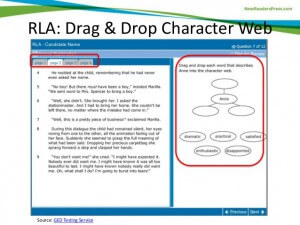GED Language Arts: What To Know

Overview of the Test
The test is comprised of 46 questions with an allotted time of 150 minutes. A passing grade would mean scoring 150 points. You’ll also have to take it on a computer. The content of the exam is split into two sections. Section one features Reading and Language questions as well as an extended response. The extended response comes after the R&L questions. Section two consists of only R&L questions.
Reading Content Makeup
Approximately 75 percent of the reading content on the GED RLA exam will be taken from informational texts that consist of general non-fiction, social studies/science passages, and community documents. Not exactly Saturday afternoon fun-reading, in other words. This is a conscious decision on the part of the test creators to make sure you can grasp the use of language and writing outside of the familiar context of English class. An additional 25 percent of the reading content will consist of fictional selections — short stories, novel excerpts, etc.
Language Content Makeup
The purpose of the Language content is to ensure that you’re capable of editing language from everyday writing selections. As a result you may be asked to fix errors in sentence structure, capitalization, punctuation, homonyms, word choice, and possessives. This is tricky in the sense that something can sound correct without actually being correct. Therefore, it’s important that you know the rules of spelling, grammar, and syntax, rather than simply relying on judging things for the way they sound.
The Extended Response
In the extended response, you may be tasked with finding the best solution to a problem by comparing and contrasting two competing viewpoints to see which is the best for the situation. Extended response questions come from a basic scenario followed by a writing prompt. It’s up to you to create an essay that answers the question presented by the writing prompt while using supporting details and evidence for why your chosen solution is the best one. To simplify this process — which can take no longer than 45 minutes of the allotted test time — you should break your essay down into three key areas.
Firstly, you should plan what you’re going to say before you actually say it. One of the biggest mistakes that most test-takers make is that they just start writing until they have nothing left to say. The end product is what they turn in as their finished product. Big mistake. The planning stage is the most important part of the extended response section, and it’s also the one that will make writing a lot easier. Here’s what you should do when planning: develop a preferred way of evaluating the possibilities in a visual of some kind (could be two columns with each representing one of the two views that you must embrace); note the benefits of each conclusion; and determine which view you will be endorsing.
After the planning, draft your content. That means looking at the option you chose and all the supporting details you were able to connect to it, then finding examples from the text that prove your point. Write it all up in paragraph form, moving logically from one point to the next. See if you can’t start with the most important reasons and then move to the next most important and next most and so on until you’re out of supporting details. Then, tie it all up nicely with a concluding paragraph.
Planning and writing the essay may be all you have time for, considering that you have less than an hour to work, but if there is leftover time, try not to neglect the third and final step: evaluation. In other words, go back over what you’ve just written to see if it makes any sense. Read for comprehension and clarity. If you’re satisfied with what you’ve read, submit it and move on with life. If you’re not satisfied, leave the last bit of time for making any last-minute corrections. One tip that can help determine how clearly your essay flows is to start from the last sentence and read each previous sentence until you end with the first sentence. If it makes sense, you’ve probably got a great essay on your hands. If you feel lost at the end of each sentence, then it still needs work. That’s because great writing is symmetrical.
In Summary
The Reasoning Through Language Arts exam doesn’t have to be a toughie for GED test-takers. As long as you know what to expect, then you’ll know what to study. And with all the great tools available out there — both paid and for free (including the free exam on this very site) — you should be able to walk in to test day ready to conquer the GED and move on to the next exciting chapter of life. Good luck!









Hello.
I found this website absolutely useful.